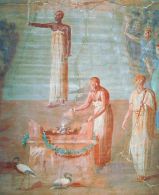
I hope now to offer some tentative and admittedly partial answers to these questions. In ancient Egypt priesthood was service—service to a particular Netjer (god) or Netjeret (goddess). The ancient Egyptian term for priest was hm ntr (pronounced 'hem netjer'), that is 'servant of the god', or in the case of a priestess hmt ntr ('hemet netjer). Servanthood involved the daily care of the divine statue. That care would involve cleansing, adorning, feeding, and praising the Netjer in whose temple or side chapel the priest served. In large temples many priests, each with specific duties, served the deity. In small village temples duties of service devolved upon one resident priest. Priesthood was entirely focused on that deity in the divine statue—a statue that had undergone the Opening of the Mouth ritual and had become the physical abode of that deity. At the very least the priest was responsible for specific rituals three times each day—dawn, midday, and nightfall. In larger temples, ones with a large priestly staff, it appears that many more rituals were conducted each day as well as on festal occasions.
High priests likely were appointed by the pharaoh. Priests of lesser rank either came from priestly families or served just one month out of every four (the length of a season in Egypt), and then returned to a secular occupation. There is no indication that priests of lower rank were appointed other than by the priests of that locale. There were councils of priests that conducted the affairs of their temple. Records indicate that priests could hold multiple priesthoods, each for a different deity. How this worked in practice we do not know. It appears that men of various secular trades could serve in the priesthood, including men from the military, those from the civil service, and advisors to the king or to the nomearch (i.e., local area governor).
What does priesthood involve today?
The essential component is service to a specific Netjer. This service should be at the very least once per day, regardless of mood, health, schedule, duties of one sort or another, vacations, or any other of life's events. If a person wants to own a dog, that person must be willing to walk that dog every day, even two or three times each day, as well as fulfilling all the other responsibilities of good dog ownership. The service I refer to is ritual service. In my book, Eternal Egypt, I give a brief ritual for the priest's deity (see pages 204-207). It takes only 10 minutes to perform. That's the absolute minimum required. An individual who has an open, vivified statue needs to care for that embodiment of the Netjer. To neglect such daily service does not invite the god's blessing.
Who should not become a priest?
Anyone who feels in their heart that he or she cannot make that daily commitment for any of a variety of reasons. Some of us just want to be in the right mood or frame of mind for interaction with our special deity. This is not bad. It does not make us somehow less than a priest. It means that we are best serving our god as devotees, following our own personal pace. Most of us are devotees. We may be a priest or priestess for one deity and a devotee for other deities. There are other reasons as well that make it impossible to perform the functions of a priest: physical health, busy schedule, family responsibilities, and debilitating mental health issues.
Who appoints priests?
We no longer have or need a pharaoh for appointing any level of priesthood.
We no longer have councils of priests to perform that function. Who then appoints priests? It is the god who calls us to such special servanthood. It is the god who plants in our hearts the desire to serve Him or Her daily in ritual. No higher authority needs do it. No higher authority can do it. It truly is a vocation. The root of the word 'vocation' is from the Latin 'vocatio,' a call or summons. The Netjer is calling the person to a special form of service.
If at some point in a person's life, may a person stop being a priest?
Illness, job, family, simple loss of a spirit of commitment—each is a valid reason. But then the person needs to explain to the deity what is happening to bring about this situation. If another person cannot be found to assume priestly responsibilities, then the ensouled divine image needs to be deconsecrated. Recall that ensouled statues in ancient Egypt were 'opened' with some form of the Opening of the Mouth ritual each year, around the feast of Wep Renpet (New Year). If a person can wait until Wep Renpet then he or she would not perform any form of the Opening of the Mouth. The ensoulment ceases and the statue reverts to being an artistic reminder of an absent deity. Now the deity certainly can decide whether or not to visit His image when called or when some ritual is performed. Another practice in ancient Egypt was to bury the image in the earth. Archeologists have found a number of very large caches of statues that no longer were used in the temple. They were discovered within temple precincts.The statue should not be burned or discarded. If a person absolutely needs to get rid of the statue, either present it to another Kemetic, ship it to me for our temples, or wrap the image in white linen and either place it in a wooden box for burial or place it directly into the earth. Since we do not have permanent temple buildings, it should be buried in a safe, out of the way place, deep into the earth. Sprinkle water and natron into the grave to purify the area.
A word about purity requirements. A servant-priest should be freshly bathed, having cleansed his or her mouth with natron. There are some women Kemetics who avoid ritual when having their period.
There is no evidence that this was the universal practice in ancient Egypt. Please see my accompanying article, “Taboo in Ancient Egypt.”
There are, however, clear moral requirements for priests. In a word, a priest was expected to lead a moral life, a life grounded in ma'at, fairness, truth-telling, avoidance of bad temper and anger. In the words of the Utterance Before the Closed Doors of the Temple as inscribed at Edfu, the servant-priest says, “I have not shown partiality in judgement. I have not consorted with the strong. I have not reproached the lowly. I have not stolen things. I have not diminished the constituents of the Eye of Ra. I have not disturbed the Balance. I have not tampered with the requirements of the Sacred Eye. . . . I am pure. I am purified.” (Eternal Egypt, p. 21) Other temples had similar statements inscribed on the doorways used by the priests. A priest was expected to be fair in his dealings, showing a grateful spirit to the gods. Priests, in essence, were expected to lead moral lives.
©2011 Richard Reidy
This material is copyrighted. All rights reserved.
Today there is, among the various Kemetic practitioners, some discussion of Kemetic (Egyptian) priesthood and its role today. The following list represents some of the questions that arise today:
What was priesthood in ancient Egypt?
How did that priesthood function?
How did men and women become priests in ancient times?
What were their responsibilities? How was a priest appointed?
Who appointed priests?
A second assortment of questions arise regarding priesthood in our own era: What does being a priest mean today? What are their responsibilities? Who should not become a priest? Who appoints priests? If at some point in a person's life, may that person stop being a priest? If a person does not want to assume the responsibility of priesthood, what would be the option?
by Richard Reidy
Kemetic Priesthood Today
ARTICLES
Price : $15.00
The Kemetic Temple of San Jose is offering a CD of the General Ritual for Sekhmet recited by temple members and author Richard Reidy. This ritual is based on ancient temple texts & appears in Eternal Egypt: Ancient Rituals for the Modern World. The ritual is a beautiful, meditative journey into the heart of ancient worship. All proceeds from the CD go for temple expenses.
This beautiful CD costs $15 (price incl. shipping in the U.S.)
hear a sample

SEKHMET
Ritual Recording








For questions about Kemeticism, our Kemetic Temples, and Kemetic Reconstructionism,